Jean-Léon Gérôme: Phryne Revealed Before the Areopagus
Jean-Léon Gérôme conquered the French public with his painting
Phryne before the Areopagus. Compared to Boulanger’s arbitrary interpretation, Gérôme’s work adheres more strictly to the antique evidence, especially Athenaeus’ (XIII 590de), even though the Heliaea court, mentioned by the sources, is transformed into the more famous Areopagus (which was actually only responsible for judging blood crimes). The scene shows us the orator Hyperides just as he performs the crucial act of unveiling Phryne’s charms before the eyes of the judges, who are partly astonished, partly bemused, while the woman covers her face in a rather dubious, if not paradoxical, gesture of restraint, for her body is entirely bare, an inconceivably indecent pose even for antique sources, according to which Hyperides restricted himself to baring Phryne’s breasts. Despite this touch of spicy enticement, the painting nonetheless remains fatuous and rhetorical, and betrays the predominant aims of French painting at the time – captivating the eye of the spectator with an impeccable mastery of technical means, but without any study of the underlying historical problems and their psychological or ethical implications. [
Mythimedia]





























